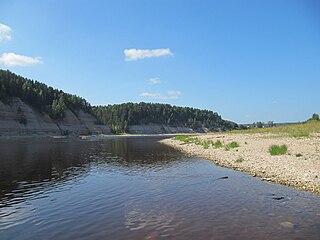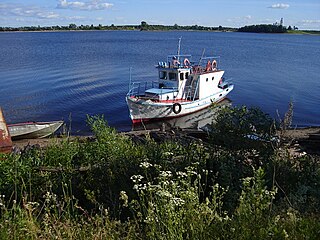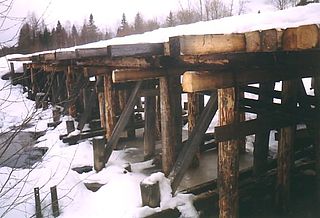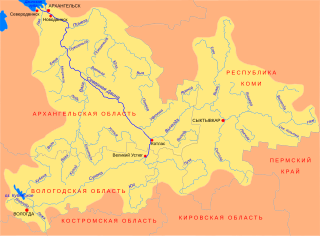Coordinates: 59°17′27″N40°13′22″E / 59.29083°N 40.22278°E

A geographic coordinate system is a coordinate system that enables every location on Earth to be specified by a set of numbers, letters or symbols. The coordinates are often chosen such that one of the numbers represents a vertical position and two or three of the numbers represent a horizontal position; alternatively, a geographic position may be expressed in a combined three-dimensional Cartesian vector. A common choice of coordinates is latitude, longitude and elevation. To specify a location on a plane requires a map projection.
| Vologda Russian: Вологда | |
|---|---|
The Vologda River in the center of the city of Vologda | |
| Country | Russia |
| Physical characteristics | |
| River mouth | Sukhona |
| Length | 155 km (96 mi) [1] |
| Basin features | |
| Basin size | 3,030 square kilometres (1,170 sq mi) [1] |

The Vologda (Russian : Вологда) is a river in Sheksninsky and Vologodsky Districts of Vologda Oblast as well as in the city of Vologda in Russia. A right-tributary of the Sukhona River, it is 155 kilometres (96 mi) long, and the area of its basin 3,030 square kilometres (1,170 sq mi). The principal tributary is the Toshnya (right). The river takes its name from the city of Vologda, which is located on the Vologda River.

Russian is an East Slavic language, which is official in the Russian Federation, Belarus, Kazakhstan and Kyrgyzstan, as well as being widely used throughout Eastern Europe, the Baltic states, the Caucasus and Central Asia. It was the de facto language of the Soviet Union until its dissolution on 25 December 1991. Although nearly three decades have passed since the breakup of the Soviet Union, Russian is used in official capacity or in public life in all the post-Soviet nation-states, as well as in Israel and Mongolia.
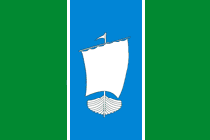
Sheksninsky District is an administrative and municipal district (raion), one of the twenty-six in Vologda Oblast, Russia. It is located in the center of the oblast and borders with Kirillovsky District in the north, Vologodsky District in the east, Poshekhonsky District of Yaroslavl Oblast in the south, and with Cherepovetsky District in the west. The area of the district is 2,500 square kilometers (970 sq mi). Its administrative center is the urban locality of Sheksna. Population: 33,375 (2010 Census); 36,007 ; 34,679 (1989 Census). The population of Sheksna accounts for 62.8% of the district's total population.

Vologodsky District is an administrative and municipal district (raion), one of the twenty-six in Vologda Oblast, Russia. It is located in the center of the oblast and borders with Ust-Kubinsky and Sokolsky Districts in the northeast, Mezhdurechensky District in the east, Gryazovetsky District in the southeast, Poshekhonsky District of Yaroslavl Oblast in the southwest, Sheksninsky District in the west, and with Kirillovsky District in the northwest. The area of the district is 4,500 square kilometers (1,700 sq mi). Its administrative center is the city of Vologda. Population: 50,438 (2010 Census); 50,956 ; 64,946 (1989 Census). As of 2010, Vologodsky District was the most populous among all the districts of Vologda Oblast.
According to Max Vasmer's Etymological Dictionary, the name "Vologda" originates from a Uralic language and means "a white city". [2] Another, less reliable account suggests that the city was named after the river and its name should be translated as "white water" [3] Folk-etymology sometimes associates the name Vologda with the Russian word volok (Russian : волок) [4] meaning "portage" or "stretch of forest". [5]

Max Julius Friedrich Vasmer was a Russian-born German linguist. He studied problems of etymology in Indo-European, Finno-Ugric and Turkic languages and worked on the history of Slavic, Baltic, Iranian, and Finno-Ugric peoples.
The source of the Vologda lies in the western part of Vologodsky District. The river flows north, enters Sheksninsky District for several kilometers, returns to Vologodsky District and turns southwest. The valley of the Vologda is heavily populated. Upstream of the city of Vologda, the river accepts the Toshnya from the right and turns east, flowing through the city of Vologda. East of Vologda, the river flows northeast past unpopulated swampy areas and joins the Sukhona in the village of Ustye-Vologodskoye.
The river basin of the Vologda comprises the major part of Vologodsky District, as well as minor areas of Sheksninsky and Gryazovetsky Districts of Vologda Oblast. It belongs to the basins of the Northern Dvina River and of the White Sea.

The Northern Dvina is a river in northern Russia flowing through the Vologda Oblast and Arkhangelsk Oblast into the Dvina Bay of the White Sea. Along with the Pechora River to the east, it drains most of Northwest Russia into the Arctic Ocean. It should not be confused with Western Dvina.

The White Sea is a southern inlet of the Barents Sea located on the northwest coast of Russia. It is surrounded by Karelia to the west, the Kola Peninsula to the north, and the Kanin Peninsula to the northeast. The whole of the White Sea is under Russian sovereignty and considered to be part of the internal waters of Russia. Administratively, it is divided between Arkhangelsk and Murmansk Oblasts and the Republic of Karelia.
The Vologda is navigable from its confluence with the Toshnya River, however, there is no passenger navigation.




